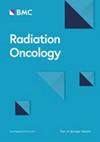Current practices of craniospinal irradiation techniques in Turkey: a comprehensive dosimetric analysis
IF 3.3
2区 医学
Q2 ONCOLOGY
引用次数: 0
Abstract
This study evaluates various craniospinal irradiation (CSI) techniques used in Turkish centers to understand their advantages, disadvantages and overall effectiveness, with a focus on enhancing dose distribution. Anonymized CT scans of adult and pediatric patients, alongside target volumes and organ-at-risk (OAR) structures, were shared with 25 local radiotherapy centers. They were tasked to develop optimal treatment plans delivering 36 Gy in 20 fractions with 95% PTV coverage, while minimizing OAR exposure. The same CT data was sent to a US proton therapy center for comparison. Various planning systems and treatment techniques (3D conformal RT, IMRT, VMAT, tomotherapy) were utilized. Elekta Proknow software was used to analyze parameters, assess dose distributions, mean doses, conformity index (CI), and homogeneity index (HI) for both target volumes and OARs. Comparisons were made against proton therapy. All techniques consistently achieved excellent PTV coverage (V95 > 98%) for both adult and pediatric patients. Tomotherapy closely approached ideal Dmean doses for all PTVs, while 3D-CRT had higher Dmean for PTV_brain. Tomotherapy excelled in CI and HI for PTVs. IMRT resulted in lower pediatric heart, kidney, parotid, and eye doses, while 3D-CRT achieved the lowest adult lung doses. Tomotherapy approached proton therapy doses for adult kidneys and thyroid, while IMRT excelled for adult heart, kidney, parotid, esophagus, and eyes. Modern radiotherapy techniques offer improved target coverage and OAR protection. However, 3D techniques are continued to be used for CSI. Notably, proton therapy stands out as the most efficient approach, closely followed by Tomotherapy in terms of achieving superior target coverage and OAR protection.土耳其目前的颅骨椎管内照射技术:综合剂量测定分析
本研究评估了土耳其中心使用的各种颅骨照射(CSI)技术,以了解其优缺点和总体效果,重点是加强剂量分布。25 家当地放疗中心共享了成人和儿童患者的匿名 CT 扫描以及靶体积和危险器官 (OAR) 结构。这些中心的任务是制定最佳治疗方案,在 20 个小节中提供 36 Gy 的剂量,PTV 覆盖率达到 95%,同时尽量减少 OAR 暴露。同样的 CT 数据被发送到美国的质子治疗中心进行比较。我们使用了各种计划系统和治疗技术(三维适形 RT、IMRT、VMAT、断层治疗)。Elekta Proknow软件用于分析参数、评估剂量分布、平均剂量、符合性指数(CI)以及靶体积和OAR的均匀性指数(HI)。并与质子疗法进行了比较。对于成人和儿童患者,所有技术都能实现出色的 PTV 覆盖率(V95 > 98%)。断层治疗接近所有 PTV 的理想 Dmean 剂量,而 3D-CRT 的 PTV_brain Dmean 较高。Tomotherapy 在 PTV 的 CI 和 HI 方面表现出色。IMRT 的小儿心脏、肾脏、腮腺和眼部剂量较低,而 3D-CRT 的成人肺部剂量最低。在成人肾脏和甲状腺方面,断层治疗的剂量接近质子治疗的剂量,而在成人心脏、肾脏、腮腺、食道和眼睛方面,IMRT则表现出色。现代放疗技术可提供更好的靶区覆盖和 OAR 保护。不过,三维技术仍在继续用于 CSI。值得注意的是,质子疗法是最有效的方法,在实现更佳的靶点覆盖和OAR保护方面,断层扫描疗法紧随其后。
本文章由计算机程序翻译,如有差异,请以英文原文为准。
求助全文
约1分钟内获得全文
求助全文
来源期刊

Radiation Oncology
ONCOLOGY-RADIOLOGY, NUCLEAR MEDICINE & MEDICAL IMAGING
CiteScore
6.50
自引率
2.80%
发文量
181
审稿时长
3-6 weeks
期刊介绍:
Radiation Oncology encompasses all aspects of research that impacts on the treatment of cancer using radiation. It publishes findings in molecular and cellular radiation biology, radiation physics, radiation technology, and clinical oncology.
文献相关原料
| 公司名称 | 产品信息 | 采购帮参考价格 |
|---|
 求助内容:
求助内容: 应助结果提醒方式:
应助结果提醒方式:


